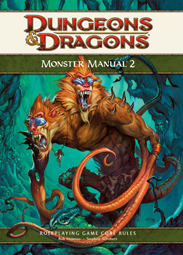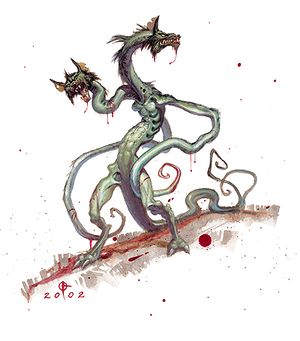Демогоргон

Демогоргон (англ. Demogorgon) — один из самых могущественных князей демонов в системе Dungeons and Dragons. Он известен под титулом «Князь Демонов», который дал себе сам за силу и влияние, что признаётся как смертными, так и демонами. Демогоргон назван одним из величайших злодеев в последнем бумажном номере журнала «Dragon»[1].
Содержание
Происхождение имени
Имя «Демогоргон» происходит от упоминающегося в ранних христианских источниках прозвища языческого божества или демона, чьё настоящее имя нельзя произносить. Предположительно оно состоит из греческих корней др.-гр. δαίμων («даймон», что означает «дух», а в христианской раннесредневековой традиции приобрело значение «демон») и др.-гр. Γοργών («горгон» — «мрачный») или др.-гр. γοργός («горгос» — «быстрый»). Сущность, именуемая Демогоргоном, присутствует в «Потерянном рае» Джона Мильтона, «Неистовом Роланде» Лудовико Ариосто, «Королеве фей» Эдмунда Спенсера и «Освобождённом Прометее» Перси Шелли[2].
История публикаций
Впервые Демогоргон появился в первой редакции D&D в книге «Eldritch Wizardry» 1976 года. В следующем году он был включён в «Monster Manual»[3] для AD&D, а в 1986 году — в «D&D Immortal Rules» (Basic D&D). Во второй редакции AD&D Демогоргон описывается как божество в книге «Monster Mythology» 1992 года[4].
Демогоргон широко описывается в третьей редакции D&D, снова став из божества князем демонов. Он впервые появился в этой редакции в книге «Book of Vile Darkness» (2002 год)[5], затем в «Fiendish Codex I: Hordes of the Abyss» (2006 год)[6]. Наиболее подробное описание Демогоргона помещено в колонке «Demonomicon of Iggwilv» журнала «Dragon» в № 357 (2007 год)[7].
Демогоргон стал одним из немногих повелителей демонов, упомянутых в «Monster Manual» четвёртой редакции (2008 год). Подробнее он описан в «Monster Manual 2» (2009 год), на обложке которого помещено его изображение[8].
Описание

Демогоргон выглядит как 18-футовое (5,5 метров) существо с чертами рептилии. У него две обезьяньи головы на змееподобных шеях, а руки заканчиваются длинными щупальцами. Его кожа имеет синевато-зелёный цвет и покрыта чешуёй, тело и ноги напоминают гигантскую ящерицу. Его внешность соответствует способности Демогоргона повелевать хладнокровными существами — змеями, рептилиями, осьминогами.
Две головы Демогоргона имеют индивидуальные личности, именуемые Аамеул (англ. Aameul) (левая) и Хетрадия (англ. Hethradiah) (правая). Глубочайшим секретом Демогоргона, скрываемым даже от его культистов и слуг, является конфликт между двумя головами, в ходе которого они пытаются подчинить или даже убить одна другую. Согласно легендам копру, у Демогоргона было две матери, из-за чего он обладает двумя личностями.
В книге «Book of Vile Darkness» головы Демогоргона описываются как головы гиены, а не обезьяны[9].
Взгляд Демогоргона может подчинять его воле или вводить в безумие, в зависимости от того, какая голова смотрит; взгляд обеих голов одновременно гипнотизирует объект. Хлыстоподобный хвост Демогоргона обладает способностью вытягивать жизненные силы; щупальцы вызывают у поражённых существ гниль, похожую на быстро протекающую проказу.
Отношения с другими владыками демонов
Самопровозглашённый титул Демогоргона оспаривается, но никто из владык демонов не способен в открытую противостоять Демогоргону. Его наиболее значительным врагом является Оркус; с Демогоргоном также враждуют Граз’зт и Фраз-Урб’луу. Супругой Демогоргона является Малкантет, Королева суккубов; до неё это место занимала Шами-Амураэ, ныне заточённая. У Малкантет и Демогоргона имеется потомство, среди которого наиболее известен Арендагрост. Ещё одним потомком Демогоргона — от смертной женщины — является камбион Драморг, упоминаемый в модуле WG 7 Castle Greyhawk. В романах Гэри Гайгэкса из серии «Gord the Rogue» упоминается брат Демогоргона, демон Мандриллагон.
Демогоргон имеет подобие альянса с древним обиритом Дагоном, который является для него чем-то вроде наставника в тайных знаниях.
Владения[Нужен перевод]
Demogorgon lives on the 88th layer of the Abyss, known as Abysm, the Brine Flats, or Gaping Maw. This is a layer consisting of a great sea of briny water broken by tall, sharp, ugly, rocky prominences rising out of the endless murky water into a sky of yellow mist. Demogorgon’s palace is two twin towers shaped very roughly like tightly coiled serpents that are covered with sharp, ugly fin-like features and spines, and crowned at the top with skull-shaped minarets. The two towers are linked by a bridge near the top. Beneath the fortress are reefs and caverns where aboleths, kraken and ixitxachitl dwell, constantly warring with each other and worshipping Demogorgon in his palace above. His towers are said to extend so far beneath the sea that it connects to the layer beneath him where he speaks with the obyrith lord Dagon.
Numerous isles dot the layer, but they all resemble Demogorgon’s palace: twin rookeries rising straight out of the sea and into the sky. The only significant landmass of the layer is a vast jungle-covered continent. Here, Demogorgon’s capital city of Lemoriax is located.
Культ Демогоргона[Нужен перевод]
Demogorgon’s cult is small compared to «true» deities, but much larger than those of most fiends. He is worshiped not only by evil humans, but also by the intelligent rays known as ixitxachitl. Cultists of Demogorgon who are not already demons are often among the most mentally disturbed members of their races.
Демогоргон в различных сеттингах[Нужен перевод]
Dragonlance
Demogorgon made an early appearance in the Dragonlance campaign setting in Dragon #85, in the short story «A Stone’s Throw Away» by Roger E Moore. The story describes Tasselhoff Burrfoot inadvertently defeating an evil wizard who had temporarily placed Demogorgon under his power.
Greyhawk
In the World of Greyhawk campaign setting, Demogorgon sometimes goes by the ancient name "Ahmon-Ibor, " or «the Sibilant Beast.» He is responsible for corrupting the paladin Sir Kargoth and transforming him and thirteen of his fellow Knight Protectors of the Great Kingdom into Oerth's first death knights.
Demogorgon in other media[Нужен перевод]
Baldur’s Gate
In the computer role-playing game Baldur's Gate II: Shadows of Amn, it is possible to make a sacrifice to Demogorgon, thus summoning some demons with no wish to be friendly. In the expansion pack Baldur's Gate II: Throne of Bhaal, an avatar of Demogorgon appears imprisoned in the dungeon known as Watcher’s Keep. The player’s standard quest is to seal the dungeon in order to keep Demogorgon imprisoned, but the player can also destroy Demogorgon’s avatar, sending him back to the Abyss.
The character has very little dialogue compared to most other bosses; his single spoken line is performed by Jim Cummings.
NetHack
In the game NetHack, Demogorgon is probably the most difficult demon in the game, as he wields a fearsome combination of stunning, poisoning, disease, and damage attacks not seen in other demons. However, he does not have a fixed place in the game, and is generally only seen when other major demons summon him (a small probability per turn). This means that he is relatively easy to avoid if the player is not deliberately baiting him.
Примечания
- ↑ Jason Bulmahn; James Jacobs, Mike McArtor, Erik Mona, F. Wesley Schneider, Todd Stewart, Jeremy Walker (September, 2007). «1d20 Villains: D&D’s Most Wanted; Preferably Dead». Dragon (Paizo Publishing) 32(4) (359): 54-69.
- ↑ DeVarque, Aardy. «Literary Sources of D&D». Archived from the original on 2007-07-21. Retrieved 2007-02-23.
- ↑ Gygax, Gary. Monster Manual. TSR, Inc., 1977.
- ↑ Sargent, Carl. Monster Mythology. TSR, 1992.
- ↑ Cook, Monte. Book of Vile Darkness. Wizards of the Coast, 2002.
- ↑ Jacobs, James, Erik Mona, Ed Stark. Fiendish Codex I: Hordes of the Abyss. Wizards of the Coast, 2006.
- ↑ Jacobs, James. «Demogorgon: Prince of Demons». Dragon #357. Paizo Publishing, July 2007.
- ↑ «Monster Manual 2». Wizards of the Coast. Retrieved 2009-03-06.
- ↑ Cook, Monte (2002-10-14). «Re: What’s so sacred about baboon heads?». Okay… Your Turn.. Retrieved 2007-08-15.
